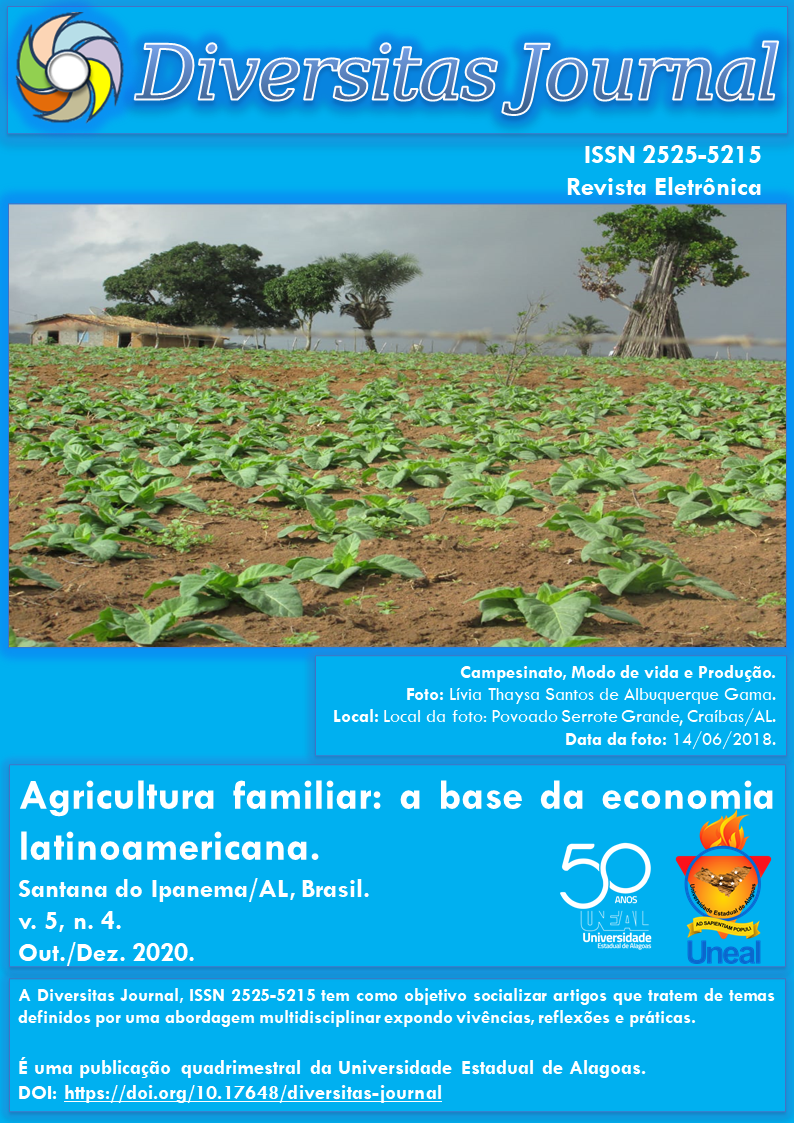Infestação de Telchin licus licus (Drury, 1770) (Lepidoptera: Castniidae) em Variedades RB de Cana-de-Açúcar
DOI:
https://doi.org/10.17648/diversitas-journal-v5i4-1227Abstract
ABSTRACT: The incidence of pest insects is one of the limiting factors for several agricultural crops, among them, the sugar cane Saccharum spp., which, despite the decrease in production in recent years, still stands out in the northeast scenario. The aim of this work was to compare the percentage of infestation of giant moth borer Telchin licus licus (Drury, 1770) (Lepidoptera: Castniidae) in RB (Republic of Brazil) varieties of sugar cane. Two cultivation systems were used, rainfed (four cycles) and irrigated (three cycles). For each cultivation system the experimental design was a randomized block design with four replications. For rainfed crop, eight varieties were used: RB72454, RB931003, RB867515, RB92579, RB971755, RB863129, RB951541 and RB93509. For irrigated crop, besides the varieties mentioned, the variety RB98710 was included. The assessment of the percentage of infestation of giant moth borer obtained during the harvest time, selecting at random 15 sugar cane stalks per plot, verifying the existence of internodes damaged by the action of the pest. Means were compared by Tukey test at 5% probability. In the first two years of evaluation of rainfed cultivation, and in the first year of irrigated cultivation, it was not possible to identify the varieties more and less infested by T. licus licus. In subsequent years, in both cropping systems, all varieties under study were characterized by a similar behavior in relation to the attack of the giant moth borer. In both cultivation systems, there was a decrease in crop productivity during annual evaluations.
KEYWORDS: Saccharum spp., Telchin licus licus, behavior of varieties.
Metrics
Downloads
Published
How to Cite
Issue
Section
License
Copyright (c) 2020 Hully Monaísy Alencar Lima, Vanessa de Melo Rodrigues, Alexandre Guimarães Duarte, Josemildo Verçosa de Araujo Júnior, Juliana Ferreira de Lima, Ivanildo Soares de Lima, Adriana Guimarães Duarte

This work is licensed under a Creative Commons Attribution 4.0 International License.
The Diversitas Journal expresses that the articles are the sole responsibility of the Authors, who are familiar with Brazilian and international legislation.
Articles are peer-reviewed and care should be taken to warn of the possible incidence of plagiarism. However, plagiarism is an indisputable action by the authors.
The violation of copyright is a crime, provided for in article 184 of the Brazilian Penal Code: “Art. 184 Violating copyright and related rights: Penalty - detention, from 3 (three) months to 1 (one) year, or fine. § 1 If the violation consists of total or partial reproduction, for the purpose of direct or indirect profit, by any means or process, of intellectual work, interpretation, performance or phonogram, without the express authorization of the author, the performer, the producer , as the case may be, or whoever represents them: Penalty - imprisonment, from 2 (two) to 4 (four) years, and a fine. ”


















